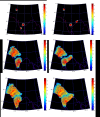A diffusion based study of population dynamics: Prehistoric migrations into South Asia
- PMID: 28493906
- PMCID: PMC5426639
- DOI: 10.1371/journal.pone.0176985
A diffusion based study of population dynamics: Prehistoric migrations into South Asia
Abstract
A diffusion equation has been used to study migration of early humans into the South Asian subcontinent. The diffusion equation is tempered by a set of parameters that account for geographical features like proximity to water resources, altitude, and flatness of land. The ensuing diffusion of populations is followed in time-dependent computer simulations carried out over a period of 10,000 YBP. The geographical parameters are determined from readily-available satellite data. The results of our computer simulations are compared to recent genetic data so as to better correlate the migratory patterns of various populations; they suggest that the initial populations started to coalesce around 4,000 YBP before the commencement of a period of relative geographical isolation of each population group. The period during which coalescence of populations occurred appears consistent with the established timeline associated with the Harappan civilization and also, with genetic admixing that recent genetic mapping data reveal. Our results may contribute to providing a timeline for the movement of prehistoric people. Most significantly, our results appear to suggest that the Ancestral Austro-Asiatic population entered the subcontinent through an easterly direction, potentially resolving a hitherto-contentious issue.
Conflict of interest statement
Figures







References
-
- Barceló JA, Castillo FD, editors. Simulating Prehistoric and Ancient Worlds, Springer; 2016.
-
- Vahia MN, Ladiwala U, Mahathe P, Mathur D., Population Dynamics of Early Human Migration in Britain. PLoS ONE. 2016; 11(5): e0154641 doi: 10.1371/journal.pone.0154641 - DOI - PMC - PubMed
-
- Tamang R, Thangaraj K. Genomic view on the peopling of India. Investig. Genet. 2012; 3: 20 doi: 10.1186/2041-2223-3-20 - DOI - PMC - PubMed
-
- Normile D. SNP study supports southern migration route to Asia. Science. 2009; 326: 1470–1476. doi: 10.1126/science.326.5959.1470 - DOI - PubMed
-
- Reich D, Thangaraj K, Patterson N, Price AL, Singh L. Reconstructing Indian population history. Nature. 2009; 461: 489–494. doi: 10.1038/nature08365 - DOI - PMC - PubMed
Publication types
MeSH terms
LinkOut - more resources
Full Text Sources
Other Literature Sources

